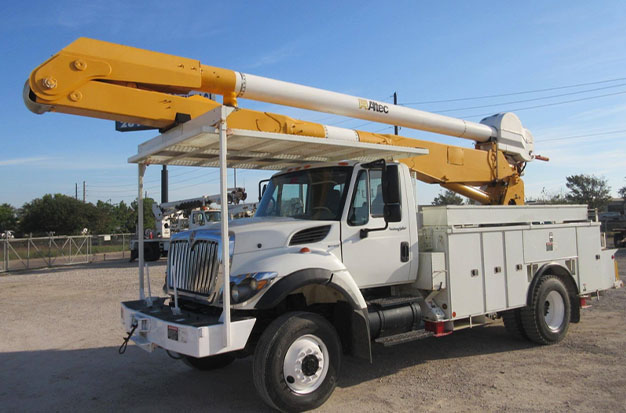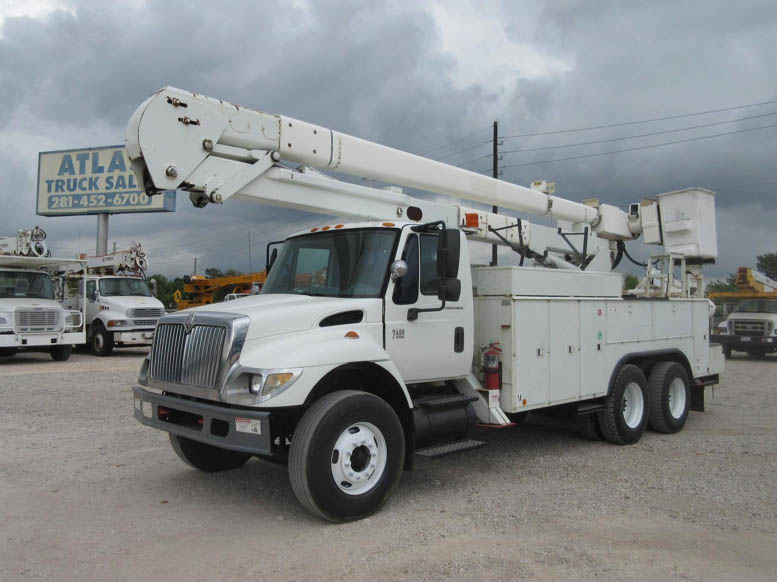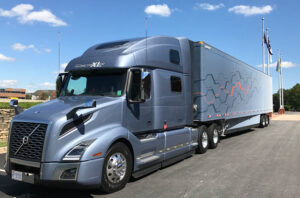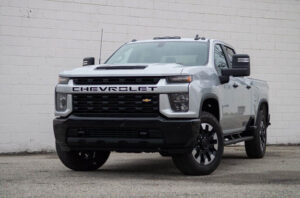
How Much Does a Bucket Truck Weigh – Why Consider Weigh?
A vehicle with a crane-like apparatus on the back is known as a bucket truck. To reach high spots, the crane’s arm can be stretched and turned. Bucket trucks are used by utility companies to maintain infrastructure such as electrical wires. A bucket truck can weigh anything from 10000 pounds (4500 kilograms) to 84000 pounds (38000 kilograms). Gross vehicle weight rating (GVWR), or the maximum safe weight of the truck and all of its payload, is how these numbers are expressed.
History of Bucket Trucks
The first bucket truck design appeared in the early 1900s. About the same time, internal combustion engines became popular. Agriculture was the first industry to use bucket trucks, especially in the field of fruit harvesting. Many orchard workers claim compensation for accidents that occur when they use ladders to harvest fruit from tall trees. Finally, people began to use trucks equipped with aerial work platforms (AWP) to make harvesting faster, easier and safer. This early design was called “cherry picker”, which still stands for some bucket elevators today. Other industries found the advantages of cherry pickers and eventually began to use the same invention for their own use. These industries include:
- Power company
- Forestry
- Mining
- Build
- Home reconstruction
Since then, the design of bucket trucks has changed in terms of capacity, efficiency and safety, but the basic functions remain unchanged.
Type of Bucket Truck
Bucket trucks come in many different shapes and sizes, each with its own weight. The three main types of bucket trucks are telesquirt, material handling vehicle, eccentric and non eccentric, insulated and non insulated, crawler bucket and articulated.
- Telesquirt bucket truck
Unlike the articulated version, the straight arm on these trucks has no steering knuckle and can only be extended and retracted.
Compared with any other boom, the larger horizontal range provided by the telescopic bucket truck is one of its largest assets. This is a great feature for working in a restricted access location.
- Material handling shovel truck
These trucks are designed to transport the right amount of materials without additional equipment or complex rigging, making them an ideal choice for use with lifting workers at the same time.
- Eccentric bucket truck
Eccentric bucket trucks are another example of articulated vehicles. The eccentric boom allows the bucket to move outside the center of the truck, thereby expanding the side range, which may be beneficial in forestry, utilities, and construction work.
- Non eccentric bucket truck
Since non eccentric bucket trucks cannot move the bucket out of the middle of the truck, their range is narrower. However, when your main concern is working height, such as Terex tc55 or tm125, this is not always necessary.
- Insulated bucket truck
Utility workers and workers using cables are the most common users of insulated bucket trucks. These vehicles help prevent accidental electric shock by using dielectric materials in two components: boom and bucket.
- Non insulated bucket truck
Posi plus 800 and versalift sst-36-ne are two types of non insulated bucket trucks with fiberglass covers not included on the boom and bucket. They cannot prevent electric shock. Instead, they are made of steel only.
- Articulated arm forklift
They are also called “spray bars” because they have unusual deployment capabilities, just like steering knuckle suspenders with additional telescopic functions. This allows for greater lateral extension at higher heights, while reducing the tail swing on the other side of the work being done.
In many cases, this type of design limits the frequency with which your bucket truck must be relocated, thereby increasing productivity, such as the Terex lt40 and versalift vst-7500-e108
Importance of Bucket Truck Weight
Due to the boom and bucket system, bucket trucks are usually much heavier than ordinary vehicles with the same length, width and height. Although this extra weight may affect the fuel economy of trucks, it is very important for their basic functions. When the bucket truck extends its boom and positions its bucket, the center of gravity of the entire vehicle moves upward or sideways.
Through this expansion, the stability of the truck needs to resist wind, bucket movement and other external factors. The farther the range, the heavier the bucket truck is usually. Bucket truck manufacturers always state the maximum bucket capacity and GVWR of their bucket trucks. To learn more about GVWR, please check out this informative article.
Bucket Capacity of Bucket Truck
Bucket capacity refers to the maximum weight that the bucket can safely carry, which varies greatly between bucket cars of different sizes. Generally speaking, bucket capacity can range from 400 pounds (181 kg) to 2000 pounds (907 kg). For stability and safety reasons, the bucket capacity usually decreases as the boom is extended or the extension range increases.
Platform Height / Range of Bucket Truck
Different bucket trucks are designed for different vertical and horizontal ranges, and these specifications largely depend on the industry. Some common platform height categories are:
- 29 to 45 feet – these are common in telecommunications and grid maintenance because nearby poles are usually 40 feet tall. They can also be used for house maintenance, window cleaning services and rescue operations.
- 45 to 65 feet – these are medium to heavy trucks that can be used to repair some power distribution lines and work on trees.
- 65 to 100 feet – these bucket trucks have access to almost all telegraph poles and most trees in North America. They are also useful in fleet work.
More than 100 feet – these overhead trucks allow utility workers to reach areas that would otherwise require helicopters. They are usually used to repair wind energy structures.
As of 2017, the world’s largest commercial bucket truck is bronto skylift model Si 219 hdt-c. The truck has a platform height of 219 feet (67 meters) and a horizontal range of 89 feet (27 meters). However, the same company claims that its tallest exhibition model can reach 367 feet.

What Should be Considered When Buying & Renting Bucket Trucks?
Bucket trucks are special equipment, and their price is quite expensive, which is understandable. The new light bucket truck costs between $40000 and $150000, while the new heavy truck may cost $450000 or more.
If you own a company that needs to use bucket trucks regularly to provide services, it may be a good idea to buy one. However, if you only need to use a bucket truck once or in rare cases, please consider renting one.
The rental cost of bucket trucks may vary depending on the season, location, and type of vehicle. On average, the rental cost of bucket trucks is about $600 per day, $1800 per week, or $5200 per month.
- Platform capacity
The weight of the bucket truck is an important factor to consider when buying. The weight will determine how much the truck can carry and how it performs on the road.
There are several different factors that affect the weight of a bucket truck. The first is the size of the barrel. The larger the bucket, the heavier the truck. The second factor is the material of the barrel.
Steel barrels are much heavier than plastic barrels. Finally, the type of engine will also affect the weight of the truck. Diesel engines will be much heavier than gasoline engines.
- Engine type
Another factor to consider when buying a bucket truck is the type of engine. There are two main types of engines, gasoline and diesel. Gasoline engines are usually lighter and more fuel-efficient. The diesel engine is heavier and has higher torque, but the maintenance cost is higher.
The size of the engine will also affect the weight of the truck. Smaller engines will be lighter than larger engines.
- Transmission type
Transmission type is another factor that affects the weight of bucket trucks. There are two main types of transmissions, automatic and manual. Automatic transmissions are usually heavier than manual transmissions.
The type of drive system also affects the weight of the bucket truck. Rear wheel drive trucks will be heavier than front wheel drive trucks.
- Tailgate type
The type of tailgate is another factor to consider when buying a bucket truck. There are two main types of tailgate, swing and lift. Swing tailgate is usually heavier than lift tailgate.
The material of the tailgate will also affect the weight of the truck. The steel tailgate will be much heavier than the plastic tailgate.
- Working height
Working height is the last factor to consider when buying a bucket truck. The working height will determine how high the bucket can reach. The higher the working height, the heavier the truck.
- Side extension
Side extension is another factor to consider when buying bucket trucks. Lateral extension will determine how far the bucket can reach the side. The longer the side distance, the heavier the truck.
Bucket Trucks FAQs
- What is GVWR?
GVWR (gross vehicle weight class) is the maximum safe weight of the vehicle.
In other words, it is the weight of the vehicle plus the weight of passengers, fuel and any cargo (or machinery).
Bucket truck GVWR is essentially the weight of the bucket truck plus the weight of the lifting machinery on it.
- What is the lifting weight of the 40 foot boom?
It depends on the exact model. Most 40 foot cantilever lifts weigh at least 11000 pounds. For example, genie z-34/22n jib weighs 11500 pounds.
- What is the 60 foot boom lifting weight?
It depends on the exact model. Most 60 foot cantilever lifts weigh at least 15000 pounds. For example, the spirit S-60 J weighs 16650 pounds.
- What is the GVWR of a bucket truck?
GVWR related to truck weight refers to the weight of the truck itself and the weight of high-altitude lifting machinery installed on the truck.



Average Rating